Effects of Long-Term Straw Return and Environmental Factors on the Spatiotemporal Variability of Soil Organic Matter in the Black Soil Region: A Case Study
Abstract
1. Introduction
2. Materials and Methods
2.1. Study Area
2.2. Laboratory Analysis
2.3. Statistical and Geostatistical Analyses
2.4. Statistical Assessment
3. Results and Discussion
3.1. Descriptive Analysis of SOM
3.2. Spatial Structure Analysis of SOM
3.3. Spatial and Temporal Variation of SOM
3.4. Effects of Straw Return and Environmental Factors on SOM
3.4.1. Effects of Soil Types on SOM Accumulation
3.4.2. Effects of Soil Texture on SOM Accumulation
3.4.3. Effects of Elevation on SOM
3.4.4. Effects of Straw Return on SOM Accumulation
4. Conclusions
Author Contributions
Funding
Institutional Review Board Statement
Informed Consent Statement
Data Availability Statement
Conflicts of Interest
References
- IUSS Working Group WRB. World Reference Base for Soil Resources 2014; FAO: Rome, Italy, 2015. [Google Scholar]
- Xu, X.Z.; Xu, Y.; Chen, S.C.; Xu, S.G.; Zhang, H.W. Soil loss and conservation in the black soil region of Northeast China: A retrospective study. Environ. Sci. Policy 2010, 13, 793–800. [Google Scholar] [CrossRef]
- Fabrizzi, K.P.; Moron, A.; García, F.O. Soil carbon and nitrogen organic fractions in degraded vs. non-degraded Mollisols in Argentina. Soil Sci. Soc. Am. J. 2003, 67, 1831–1841. [Google Scholar] [CrossRef]
- Russell, A.E.; Laird, D.; Parkin, T.B.; Mallarino, A.P. Impact of nitrogen fertilization and cropping system on carbon sequestration in Midwestern Mollisols. Soil Sci. Soc. Am. J. 2005, 69, 413. [Google Scholar] [CrossRef]
- Ondrasek, G.; Bakić Begić, H.; Zovko, M.; Filipović, L.; Meriño-Gergichevich, C.; Savić, R.; Rengel, Z. Biogeochemistry of soil organic matter in agroecosystems & environmental implications. Sci. Total Environ. 2019, 658, 1559–1573. [Google Scholar]
- Ciais, P.; Gervols, S.; Vuichard, N.; Piao, S.L.; Viovy, N. Effects of land use change and management on the European cropland carbon balance. Glob. Chang. Biol. 2011, 17, 320–338. [Google Scholar] [CrossRef]
- Li, H.; Pei, J.B.; Wang, J.K.; Li, S.Y.; Gao, G.W. Organic carbon density and storage of the major black soil regions in Northeast China. J. Soil Sci. Plant Nut. 2013, 13, 883–893. [Google Scholar] [CrossRef]
- Gutiérrez-Girón, A.; Díaz-Pinés, E.; Rubio, A.; Gavilán, R.G. Both altitude and vegetation affect temperature sensitivity of soil organic matter decomposition in Mediterranean high mountain soils. Geoderma 2015, 237–238, 1–8. [Google Scholar] [CrossRef]
- Wang, S.; Wang, X.; Ouyang, Z. Effects of land use, climate, topography and soil properties on regional soil organic carbon and total nitrogen in the Upstream Watershed of Miyun Reservoir, North China. J. Env. Sci.-China 2012, 24, 387–395. [Google Scholar] [CrossRef]
- Lou, Y.; Xu, M.; Wang, W.; Sun, X.; Zhao, K. Return rate of straw residue affects soil organic C sequestration by chemical fertilization. Soil Till. Res. 2011, 113, 70–73. [Google Scholar] [CrossRef]
- Dou, X.; He, P.; Zhu, P.; Zhou, W. Soil organic carbon dynamics under long-term fertilization in a black soil of China: Evidence from stable C isotopes. Sci. Rep. 2016, 6, 21488. [Google Scholar] [CrossRef]
- Chang, L.; Meng, L.; Jun, C.; Bo, L.; Changming, F. Effects of straw carbon input on carbon dynamics in agricultural soils: A meta-analysis. Glob. Chang. Biol. 2014, 20, 1336–1361. [Google Scholar]
- Lu, F. How can straw incorporation management impact on soil carbon storage? A meta-analysis. Mitig. Adapt. Strateg. Glob. Chang. 2015, 20, 1545–1568. [Google Scholar] [CrossRef]
- Emanuele, L.; Francesca, B.; Panos, P.; Luca, M.; Arwyn, J. Potential carbon sequestration of European arable soils estimated by modelling a comprehensive set of management practices. Glob. Chang. Biol. 2014, 20, 3557–3567. [Google Scholar]
- Lu, F.; Wang, X.; Han, B.; Ouyang, Z.; Duan, X.; Zheng, H.; Miao, H. Soil carbon sequestrations by nitrogen fertilizer application, straw return and no-tillage in China’s cropland. Glob. Chang. Biol. 2009, 15, 281–305. [Google Scholar] [CrossRef]
- Wang, J.; Wang, X.; Xu, M.; Feng, G.; Zhang, W.; Lu, C.A. Crop yield and soil organic matter after long-term straw return to soil in China. Nutr. Cycl. Agroecosys. 2015, 102, 371–381. [Google Scholar] [CrossRef]
- Pittelkow, C.M.; Liang, X.; Linquist, B.; Groenigen, K.J.V.; Lee, J.; Lundy, M.; Gestel, N.V.; Six, J.; Venterea, R.; Kessel, C.V. Productivity limits and potentials of the principles of conservation agriculture. Nature 2015, 517, 365–368. [Google Scholar] [CrossRef] [PubMed]
- Poeplau, C.; Kätterer, T.; Bolinder, M.A.; Börjesson, G.; Berti, A.; Lugato, E. Low stabilization of aboveground crop residue carbon in sandy soils of Swedish long-term experiments. Geoderma 2015, 237–238, 246–255. [Google Scholar] [CrossRef]
- Powlson, D.S.; Glendining, M.J.; Coleman, K.; Whitmore, A.P. Implications for Soil Properties of Removing Cereal Straw: Results from Long-Term Studies. Agron. J. 2011, 103, 279–287. [Google Scholar] [CrossRef]
- Sosulski, T.; Korc, M. Effects of different mineral and organic fertilization on the content of nitrogen and carbon in soil organic matter fractions. Ecol. Chem. Eng. A 2011, 18, 601–609. [Google Scholar]
- Šimanský, V.; Juriga, M.; Jonczak, J.; Uzarowicz, Ł.; Stępień, W. How relationships between soil organic matter parameters and soil structure characteristics are affected by the long-term fertilization of a sandy soil. Geoderma 2019, 342, 75–84. [Google Scholar] [CrossRef]
- Zhou, Y.; Hartemink, A.E.; Shi, Z.; Liang, Z.; Lu, Y. Land use and climate change effects on soil organic carbon in North and Northeast China. Sci. Total Environ. 2019, 647, 1230–1238. [Google Scholar] [CrossRef] [PubMed]
- Zhang, Q.; Zhang, J.; Guo, E.; Yan, D.; Sun, Z. The impacts of long-term and year-to-year temperature change on corn yield in China. Theor. Appl. Climatol. 2015, 119, 77–82. [Google Scholar] [CrossRef]
- Gale, H.F. Growth and Evolution in China’s Agricultural Support Policies; United States Department of Agriculture Economic Research Service: Washington, DC, USA, 2013; Volume 153. Available online: http://www.ers.usda.gov/media/1156829/err153.pdf (accessed on 7 April 2022).
- Li, B.; Wang, G. Conservation Tillage Technique in Northeast China-The Mode in Lishu County; Scientific and Technological Literature Press: Beijing, China, 2019. [Google Scholar]
- Nachtergaele, F.; van Velthuizen, H.; Verelst, L.; Batjes, N.H.; Dijkshoorn, K.; van Engelen, V.; Fischer, G.; Jones, A.; Montanarela, L. The Harmonized World Soil Database; International Union of Soil Sciences: Brisbane, Australia, 2010; pp. 34–37. [Google Scholar]
- Liu, G.; Jiang, N.; Zhang, L. Soil Physical and Chemical Analysis & Description of Soil Profiles; Standards Press of China: Beijing, China, 1996. [Google Scholar]
- Gee, G.W.; Or, D. 2.4 Particle-size analysis. In Methods of Soil Analysis: Part 4 Physical Methods; Soil Science Society of America Book Series: Madison, WI, USA, 2002; Volume 5, pp. 255–293. [Google Scholar]
- Cambardella, C.A.; Moorman, T.B.; Novak, J.M.; Parkin, T.B.; Karlen, D.L.; Turco, R.F.; Konopka, A.E. Field-scale variability of soil properties in central Iowa soils. Soil Sci. Soc. Am. J. 1994, 58, 1501–1511. [Google Scholar] [CrossRef]
- Hu, B.; Shao, S.; Fu, Z.; Li, Y.; Ni, H.; Chen, S.; Zhou, Y.; Jin, B.; Shi, Z. Identifying heavy metal pollution hot spots in soil-rice systems: A case study in South of Yangtze River Delta, China. Sci. Total Environ. 2019, 658, 614–625. [Google Scholar] [CrossRef] [PubMed]
- Xia, F.; Hu, B.; Shao, S.; Xu, D.; Zhou, Y.; Zhou, Y.; Huang, M.; Li, Y.; Chen, S.; Shi, Z. Improvement of Spatial Modeling of Cr, Pb, Cd, As and Ni in Soil Based on Portable X-ray Fluorescence (PXRF) and Geostatistics: A Case Study in East China. Int. J. Env. Res. Pub. He. 2019, 16, 2694. [Google Scholar] [CrossRef] [PubMed]
- Isaaks, E.H.; Srivastava, M.R. Applied Geostatistics; Oxford University Press: New York, NY, USA, 1989. [Google Scholar]
- R Core Team. R: A Language and Environment for Statistical Computing. R Foundation for Statistical Computing: Vienna, Austria. 2020. Available online: https://www.R-project.org/ (accessed on 6 June 2020).
- Rasband, W.S. ImageJ. 1997. Available online: http://imagej.nih.gov/ij/ (accessed on 6 June 2020).
- Zheng, L.; Wu, W.; Wei, Y.; Hu, K. Effects of straw return and regional factors on spatio-temporal variability of soil organic matter in a high-yielding area of northern China. Soil Till. Res. 2015, 145, 78–86. [Google Scholar] [CrossRef]
- Zhao, Y.; Wang, M.; Hu, S.; Zhang, X.; Ouyang, Z.; Zhang, G.; Huang, B.; Zhao, S.; Wu, J.; Xie, D. Economics-and policy-driven organic carbon input enhancement dominates soil organic carbon accumulation in Chinese croplands. Proc. Natl. Acad. Sci. USA 2018, 115, 4045–4050. [Google Scholar] [CrossRef] [PubMed]
- Hillel, D. Applications of Soil Physics; Elsevier: Amsterdam, The Netherlands, 2012. [Google Scholar]
- Fan, M.; Lal, R.; Zhang, H.; Margenot, A.J.; Wu, J.; Wu, P.; Zhang, L.; Yao, J.; Chen, F.; Gao, C. Variability and determinants of soil organic matter under different land uses and soil types in eastern China. Soil Till. Res. 2020, 198, 104544. [Google Scholar] [CrossRef]
- Hu, K.; Wang, S.; Li, H.; Huang, F.; Li, B. Spatial scaling effects on variability of soil organic matter and total nitrogen in suburban Beijing. Geoderma. 2014, 226, 54–63. [Google Scholar] [CrossRef]
- Tesfahunegn, G.B.; Tamene, L.; Vlek, P.L.G. Catchment-scale spatial variability of soil properties and implications on site-specific soil management in northern Ethiopia. Soil Till. Res. 2011, 117, 124–139. [Google Scholar] [CrossRef]
- Hobley, E.; Wilson, B.; Wilkie, A.; Gray, J.; Koen, T. Drivers of soil organic carbon storage and vertical distribution in Eastern Australia. Plant Soil 2015, 390, 111–127. [Google Scholar] [CrossRef]
- Schillaci, C.; Acutis, M.; Lombardo, L.; Lipani, A.; Fantappie, M.; Märker, M.; Saia, S. Spatio-temporal topsoil organic carbon mapping of a semi-arid Mediterranean region: The role of land use, soil texture, topographic indices and the influence of remote sensing data to modelling. Sci. Total Environ. 2017, 601, 821–832. [Google Scholar] [CrossRef] [PubMed]
- Liu, X.T.; Yan, B.X. Soil loss and food safety in Northeast China. J. Chin. Soil Water Conserv. 2009, 1, 17–19. [Google Scholar]
- Amelung, W.; Bossio, D.; Vries, W.; Kögel-Knabner, I.; Lehmann, J.; Amundson, R.; Bol, R.; Collins, C.; Lal, R. Towards a global-scale soil climate mitigation strategy. Nat. Commun. 2020, 11, 5427. [Google Scholar] [CrossRef]
- Gami, S.K.; Lauren, J.G.; Duxbury, J.M. Influence of soil texture and cultivation on carbon and nitrogen levels in soils of the eastern Indo-Gangetic Plains. Geoderma 2009, 153, 304–311. [Google Scholar] [CrossRef]
- Saidy, A.R.; Smernik, R.J.; Baldock, J.A.; Kaiser, K.; Sanderman, J. The sorption of organic carbon onto differing clay minerals in the presence and absence of hydrous iron oxide. Geoderma 2013, 209–210, 15–21. [Google Scholar]
- Six, J.; Conant, R.T.; Paul, E.A.; Paustian, K. Stabilization mechanisms of soil organic matter: Implications for C-saturation of soils. Plant Soil 2002, 241, 155–176. [Google Scholar] [CrossRef]
- Dai, W.; Huang, Y. Relation of soil organic matter concentration to climate and altitude in zonal soils of China. Catena 2006, 65, 87–94. [Google Scholar] [CrossRef]
- Djukic, I.; Zehetner, F.; Tatzber, M.; Gerzabek, M.H. Soil organic-matter stocks and characteristics along an Alpine elevation gradient. J. Plant Nutr. Soil Sc. 2010, 173, 30–38. [Google Scholar] [CrossRef]
- Tsai, C.C.; Chen, Z.S.; Kao, C.I.; Ottner, F.; Kao, S.J.; Zehetner, F. Pedogenic development of volcanic ash soils along a climosequence in Northern Taiwan. Geoderma 2010, 156, 48–59. [Google Scholar] [CrossRef]
- Blanco-Canqui, H.; Ferguson, R.B.; Shapiro, C.A.; Drijber, R.A.; Walters, D.T. Does inorganic nitrogen fertilization improve soil aggregation? Insights from two long-term tillage experiments. J. Environ. Qual. 2014, 43, 995–1003. [Google Scholar] [CrossRef]
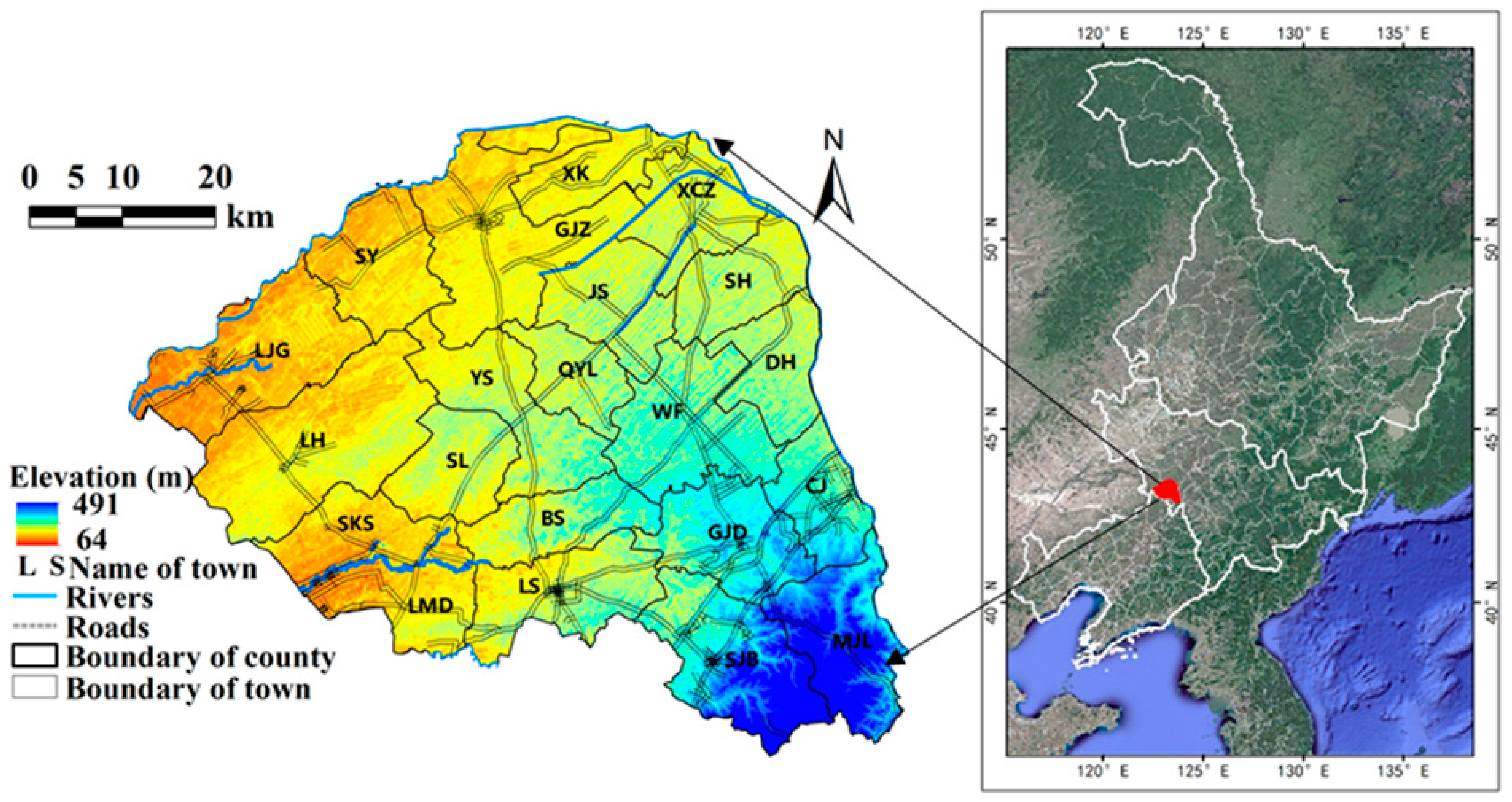
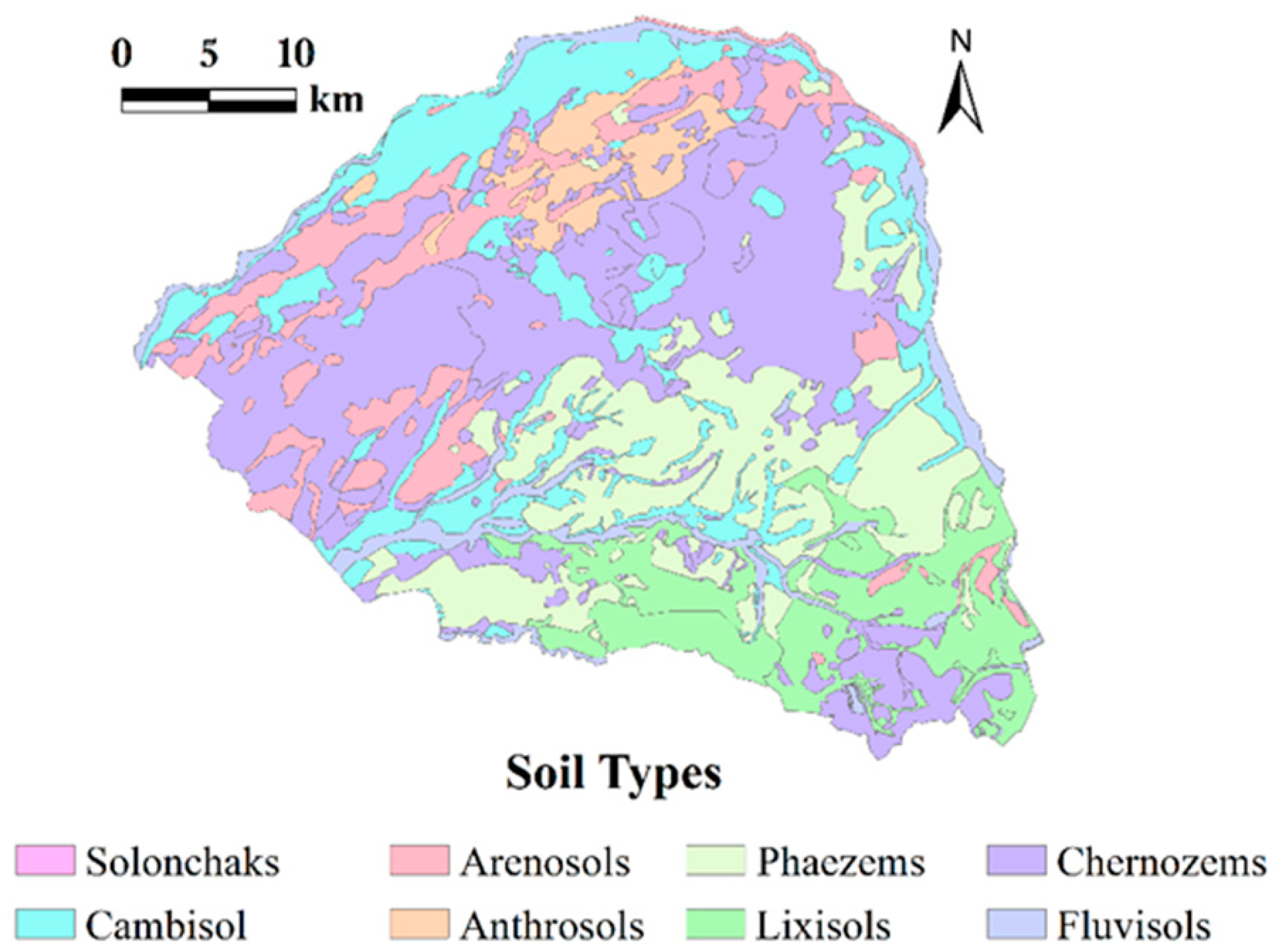
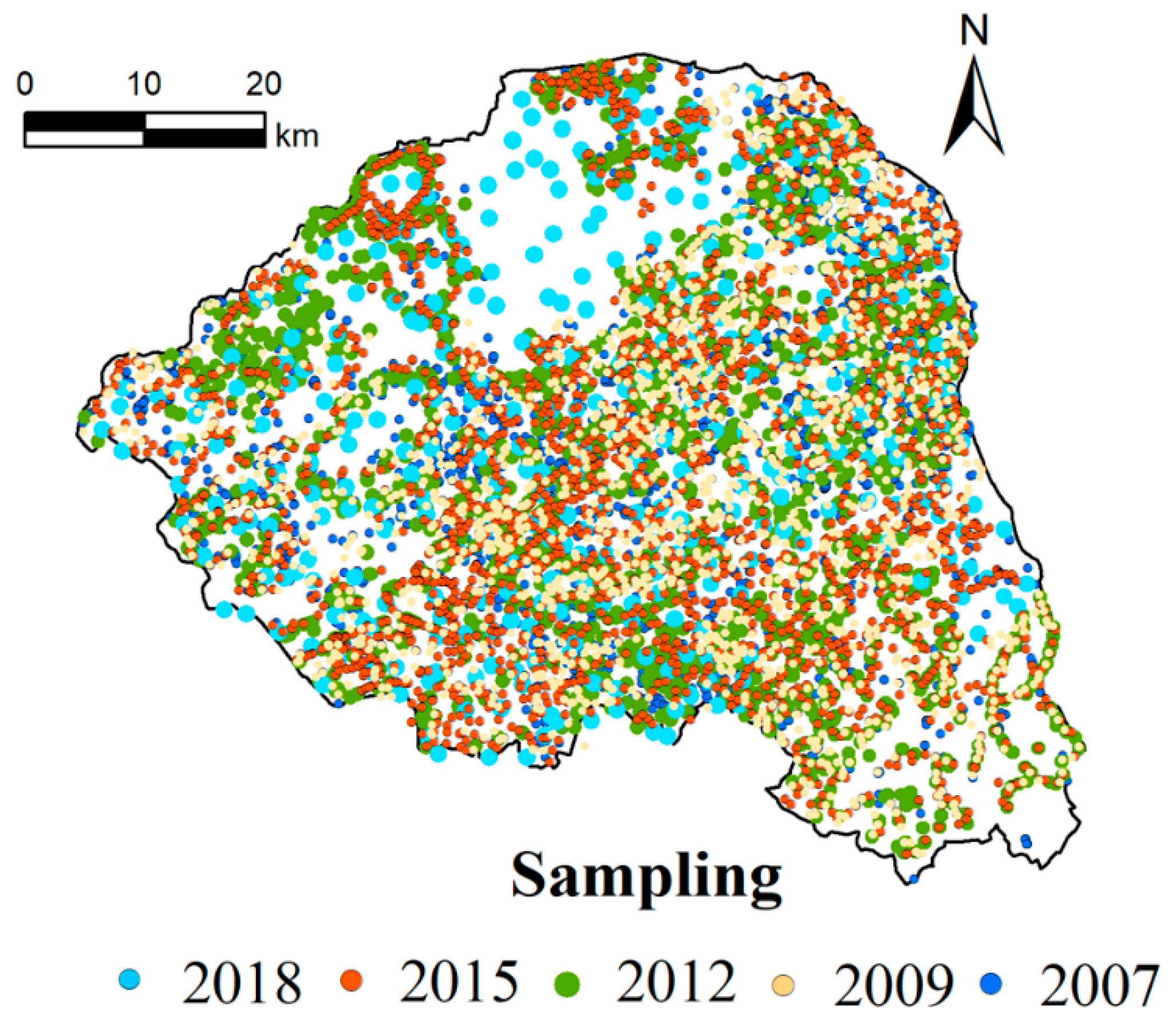
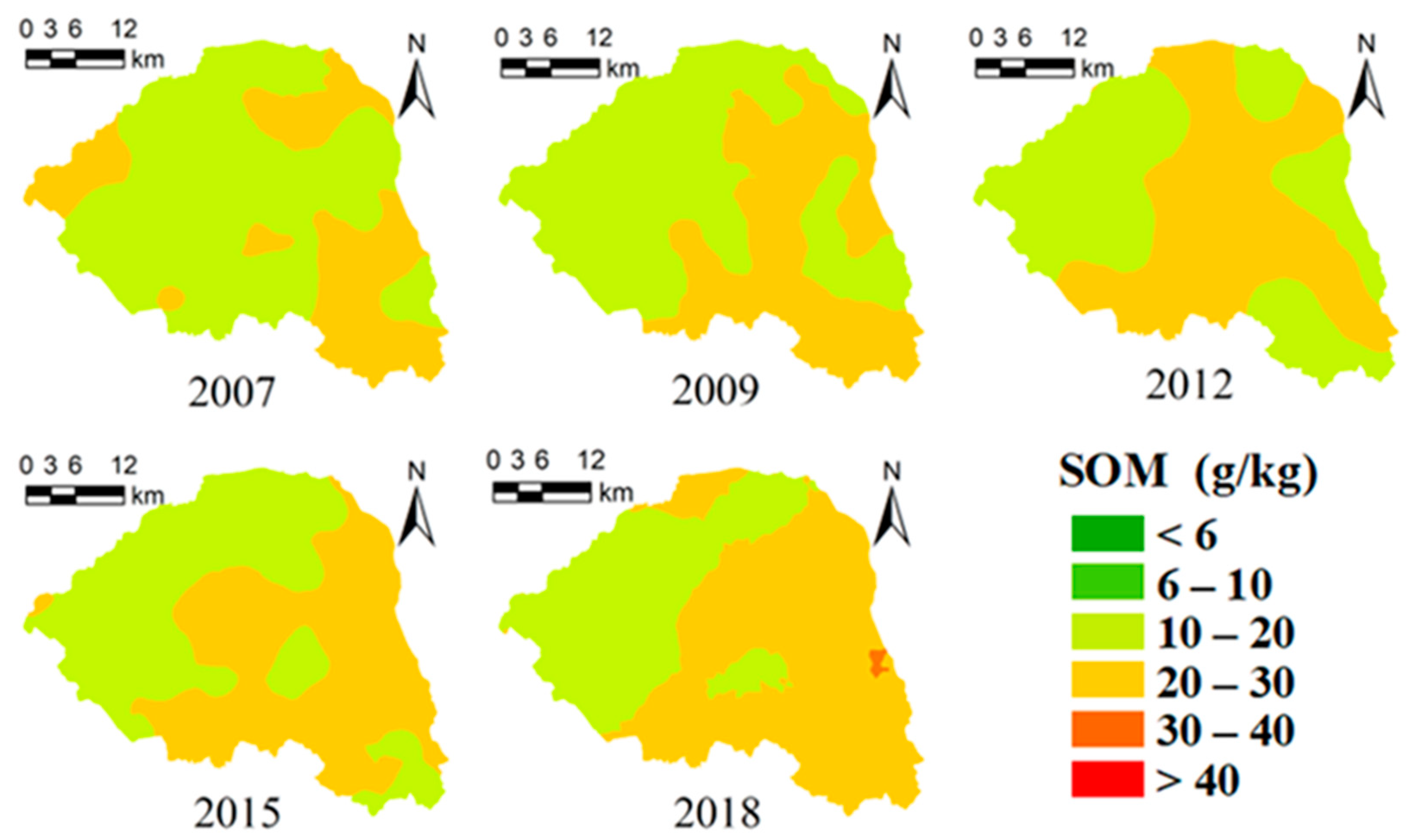
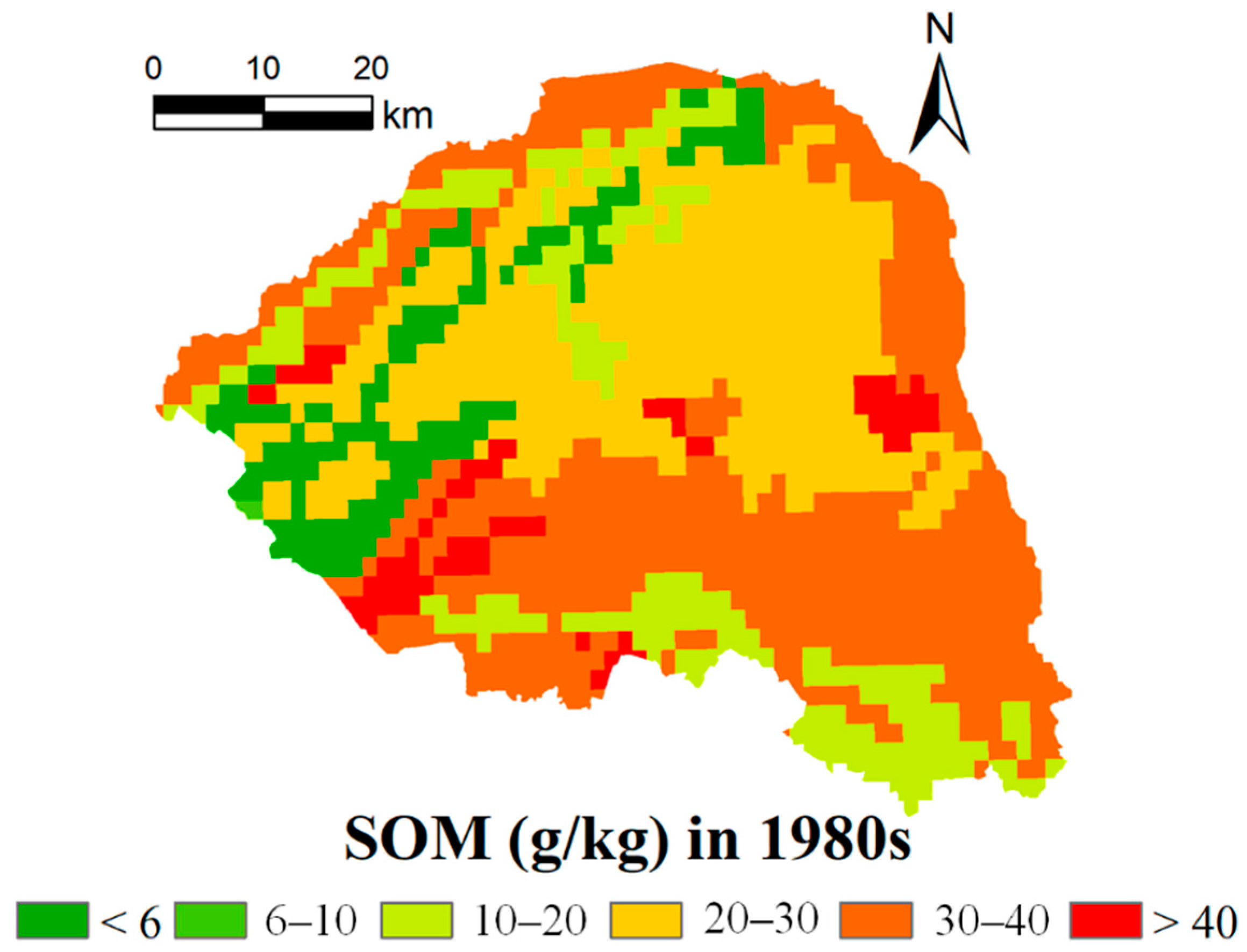
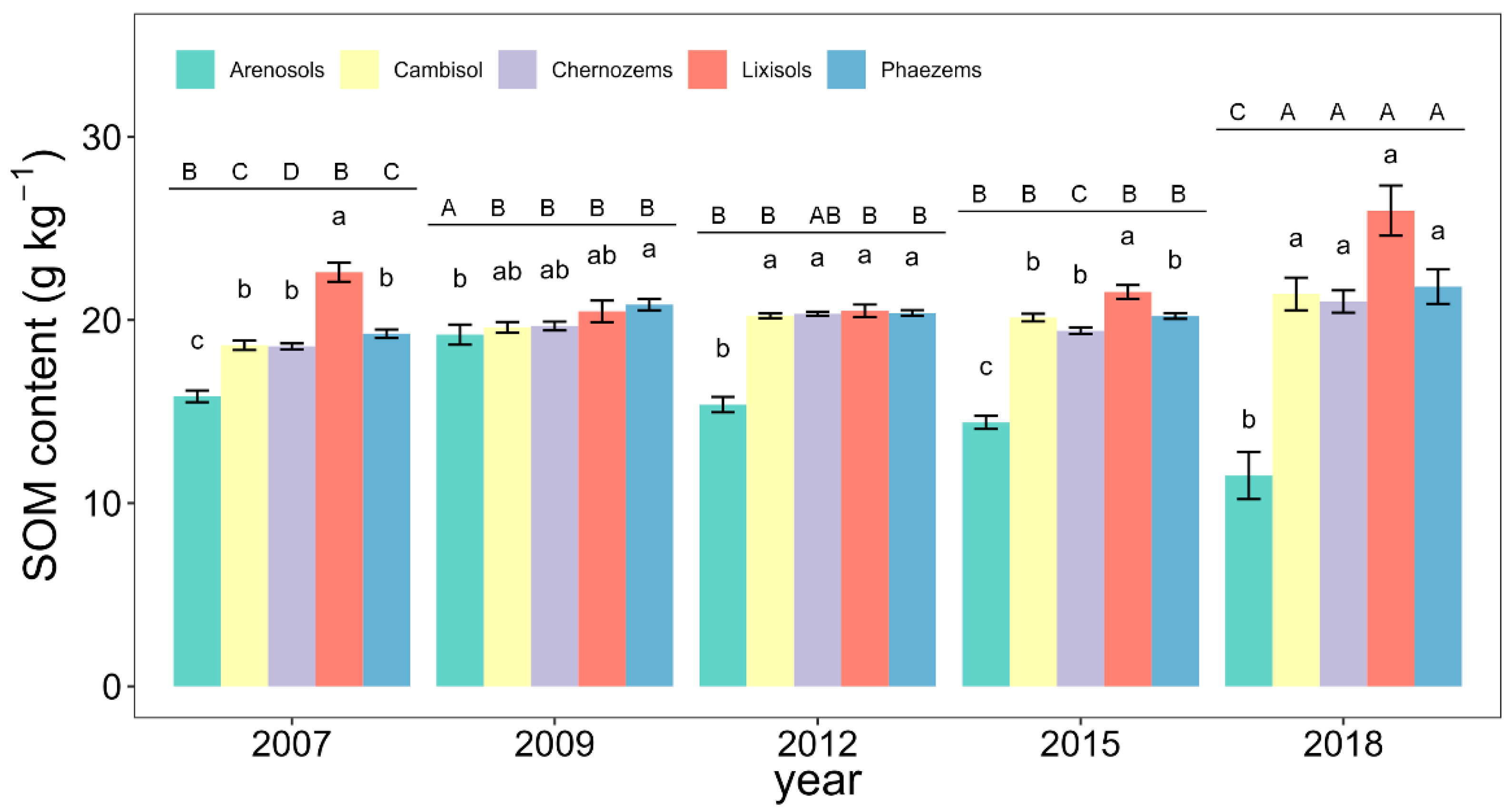
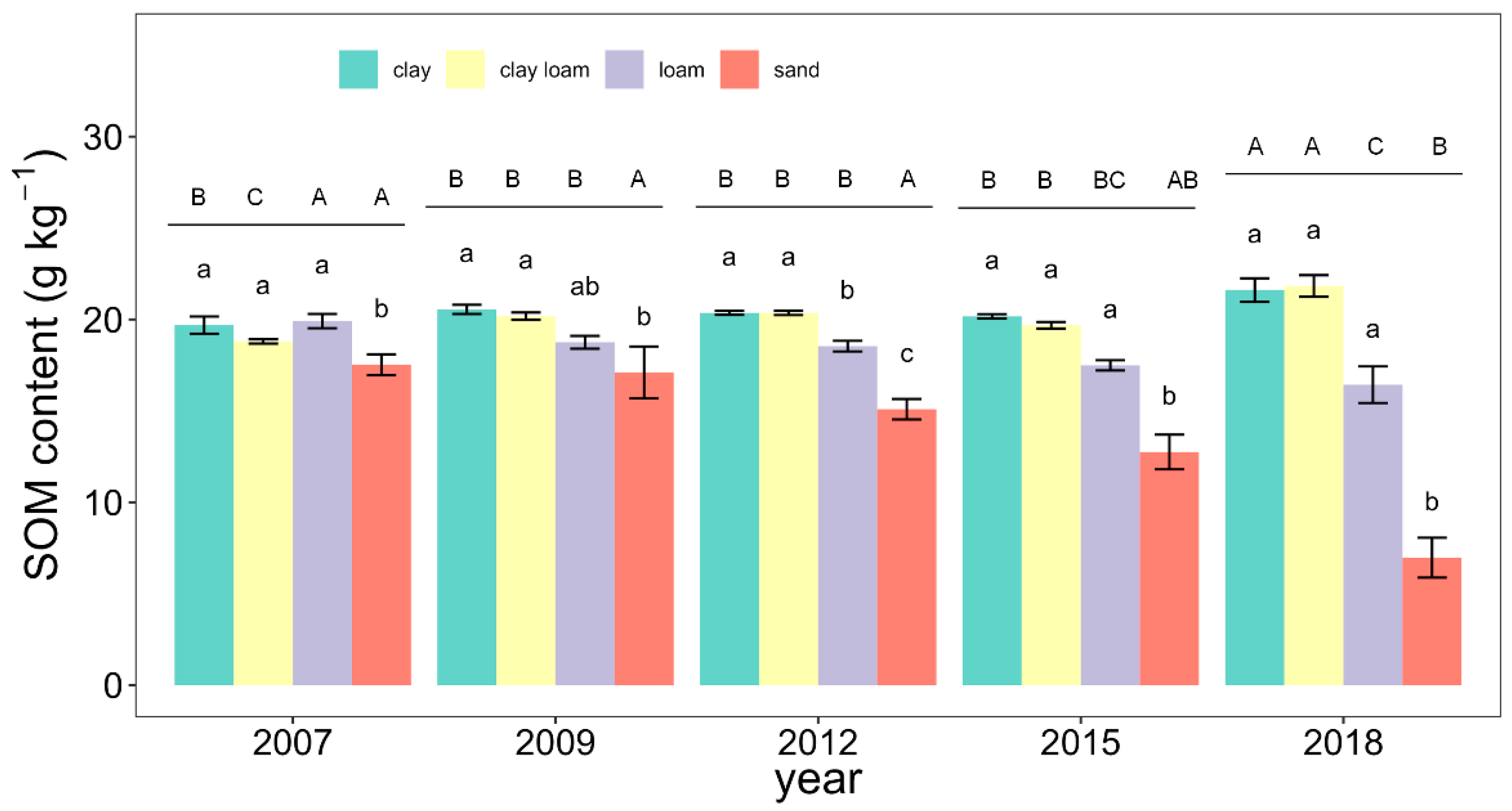
| Year | 1992 | 2007 | 2009 | 2012 | 2015 | 2018 |
|---|---|---|---|---|---|---|
| Chemical fertilizer (ton) | 137,790 | 142,352 | 148,848 | 176,676 | 186,665 | 205,179 |
| Year | 1992 | 2007 | 2009 | 2012 | 2015 | 2018 |
|---|---|---|---|---|---|---|
| The area of straw return (ha) | 0 | 15 | 218 | 2880 | 10,507 | 33,333 |
| Year | Samples | Skewness | Kurtosis | Min | Max | Mean ± SD | CV |
|---|---|---|---|---|---|---|---|
| 2007 | 2584 | 0.51 | −0.25 | 1.80 | 38.70 | 18.94 ± 5.63 d | 0.30 |
| 2009 | 1917 | 0.51 | 1.50 | 5.10 | 47.70 | 20.03 ± 6.30 b | 0.31 |
| 2012 | 1861 | −0.87 | 4.60 | 4.60 | 43.50 | 19.85 ± 3.66 bc | 0.18 |
| 2015 | 2496 | −0.17 | 1.60 | 1.60 | 45.40 | 19.42 ± 4.89 c | 0.25 |
| 2018 | 355 | 0.29 | 2.10 | 2.10 | 64.26 | 20.84 ± 7.82 a | 0.38 |
| Year | Model | Nugget (C0) | Sill | C0/Sill | Range (km) | R2 | RMSE (g kg−1) |
|---|---|---|---|---|---|---|---|
| 2007 | Exponential | 23.17 | 46.36 | 0.50 | 159.66 | 0.94 | 4.91 |
| 2009 | Exponential | 2.85 | 14.80 | 0.20 | 48.73 | 0.81 | 5.65 |
| 2012 | Exponential | 10.5 | 21.89 | 0.46 | 50.00 | 0.78 | 3.40 |
| 2015 | Exponential | 9.08 | 20.58 | 0.44 | 14.35 | 0.65 | 4.46 |
| 2018 | Gaussian | 39.52 | 62.52 | 0.63 | 30.69 | 0.95 | 6.41 |
| Year | Area (%) | |||||
|---|---|---|---|---|---|---|
| I | II | III | IV | V | VI | |
| SOM (g kg−1) | ||||||
| >40 | 30–40 | 20–30 | 10–20 | 6–10 | <6 | |
| 1980s | 30.4 | 14.1 | 0.1 | 9.0 | ||
| 2007 | 4.8 | 41.6 | 32.2 | 67.8 | ||
| 2009 | 40.5 | 59.5 | ||||
| 2012 | 50.2 | 49.8 | ||||
| 2015 | 49.4 | 50.6 | ||||
| 2018 | 0.2 | 60.5 | 39.3 | |||
| Year | 2007 | 2009 | 2012 | 2015 | 2018 |
|---|---|---|---|---|---|
| Pearson correlation | 0.054 ** | 0.038 | 0.031 | 0.067 ** | 0.370 ** |
Publisher’s Note: MDPI stays neutral with regard to jurisdictional claims in published maps and institutional affiliations. |
© 2022 by the authors. Licensee MDPI, Basel, Switzerland. This article is an open access article distributed under the terms and conditions of the Creative Commons Attribution (CC BY) license (https://creativecommons.org/licenses/by/4.0/).
Share and Cite
Yan, Y.; Ji, W.; Li, B.; Wang, G.; Hu, B.; Zhang, C.; Mouazen, A.M. Effects of Long-Term Straw Return and Environmental Factors on the Spatiotemporal Variability of Soil Organic Matter in the Black Soil Region: A Case Study. Agronomy 2022, 12, 2532. https://doi.org/10.3390/agronomy12102532
Yan Y, Ji W, Li B, Wang G, Hu B, Zhang C, Mouazen AM. Effects of Long-Term Straw Return and Environmental Factors on the Spatiotemporal Variability of Soil Organic Matter in the Black Soil Region: A Case Study. Agronomy. 2022; 12(10):2532. https://doi.org/10.3390/agronomy12102532
Chicago/Turabian StyleYan, Yang, Wenjun Ji, Baoguo Li, Guiman Wang, Bifeng Hu, Chao Zhang, and Abdul Mounem Mouazen. 2022. "Effects of Long-Term Straw Return and Environmental Factors on the Spatiotemporal Variability of Soil Organic Matter in the Black Soil Region: A Case Study" Agronomy 12, no. 10: 2532. https://doi.org/10.3390/agronomy12102532
APA StyleYan, Y., Ji, W., Li, B., Wang, G., Hu, B., Zhang, C., & Mouazen, A. M. (2022). Effects of Long-Term Straw Return and Environmental Factors on the Spatiotemporal Variability of Soil Organic Matter in the Black Soil Region: A Case Study. Agronomy, 12(10), 2532. https://doi.org/10.3390/agronomy12102532









